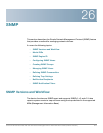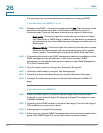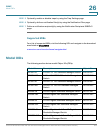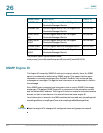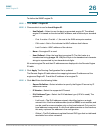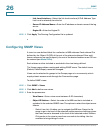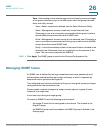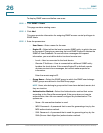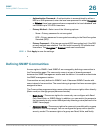
SNMP
SNMP Engine ID
Cisco Small Business 200, 300 and 500 Series Managed Switch Administration Guide (Internal Version) 526
26
To define the SNMP engine ID:
STEP 1 Click SNMP > Engine ID.
STEP 2 Choose which to use for Local Engine ID.
• Use Default—Select to use the device-generated engine ID. The default
engine ID is based on the device MAC address, and is defined per standard
as:
- First 4 octets—First bit = 1, the rest is the IANA enterprise number.
- Fifth octet—Set to 3 to indicate the MAC address that follows.
- Last 6 octets—MAC address of the device.
• None—No engine ID is used.
• User Defined—Enter the local device engine ID. The field value is a
hexadecimal string (range: 10 - 64). Each byte in the hexadecimal character
strings is represented by two hexadecimal digits.
All remote engine IDs and their IP addresses are displayed in the Remote Engine
ID table.
STEP 3 Click Apply. The Running Configuration file is updated.
The Remote Engine ID table shows the mapping between IP addresses of the
engine and Engine ID. To add the IP address of an engine ID:
STEP 4 Click Add. Enter the following fields:
• Server Definition—Select whether to specify the Engine ID server by IP
address or name.
• IP Version—Select the supported IP format.
• IPv6 Address Type—Select the IPv6 address type (if IPv6 is used). The
options are:
- Link Local—The IPv6 address uniquely identifies hosts on a single
network link. A link local address has a prefix of FE80, is not routable, and
can be used for communication only on the local network. Only one link
local address is supported. If a link local address exists on the interface,
this entry replaces the address in the configuration.
- Global—The IPv6 address is a global Unicast IPV6 type that is visible and
reachable from other networks.






